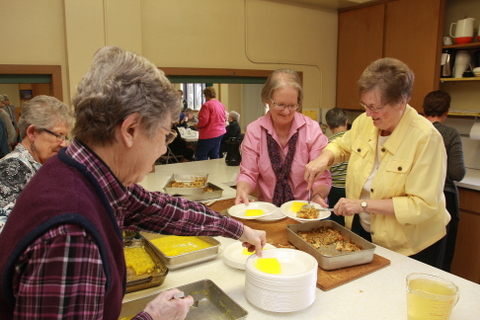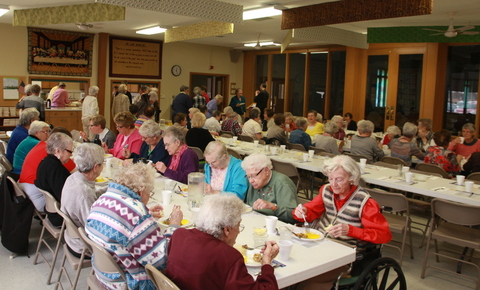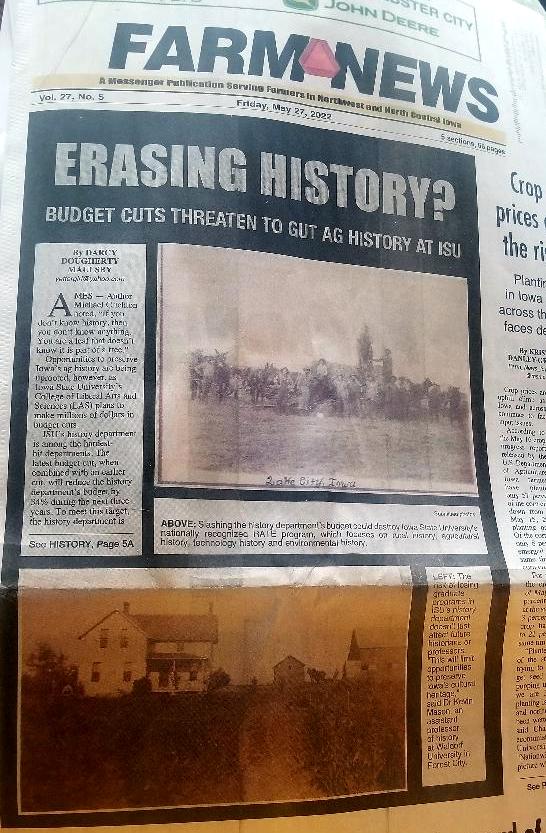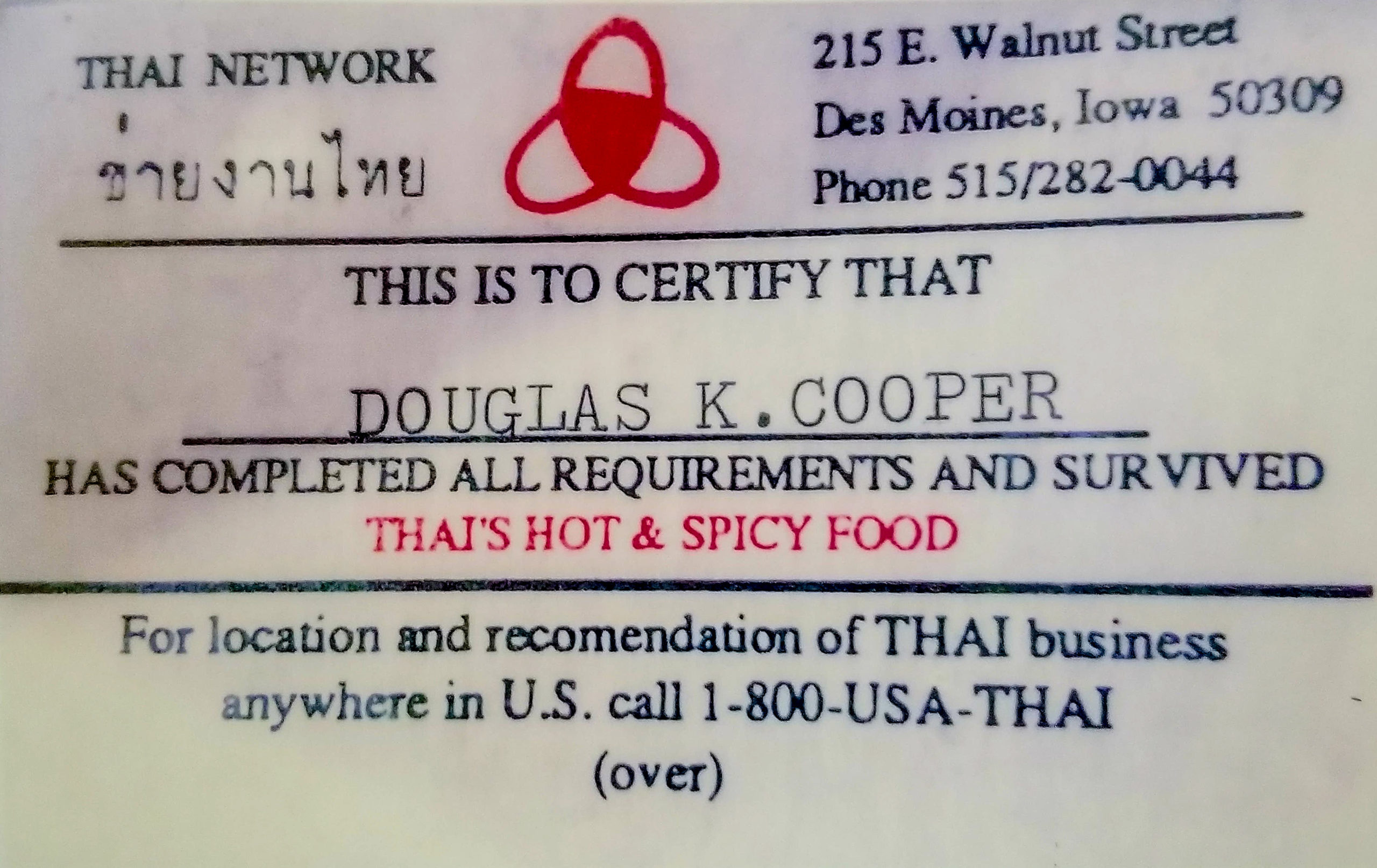
Whats HOT
Latest Posts
Iowa’s Orphan Train Heritage
Orphan trains almost became lost to history just a few decades ago, but their legacy lives on, thanks to books, historians and the National Orphan Train Complex in Kansas. Orphan trains continue to make news, in light of today’s current debatesregarding illegal immigration and amnesty.
Since orphan trains to Iowa and the Midwest were featured on 1040 WHO Radio this morning, I thought I’d share this article I wrote in 2002 for Farm News in Ft. Dodge, Iowa. I didn’t know at the time how I’d be preserving an important piece of history, since the last orphan trains ran in 1929, and many of the orphan train riders are now deceased.
For 75 years, thousands of Iowa families in small towns and farms played a crucial role in the forerunner of the modern foster care system, yet this noteworthy fact has become a lost chapter of Iowa history.
From 1854 to 1929, a network of “orphan trains” relocated as many as 300,000 children from East Coast orphanages in cities like Boston and New York City to at least 39 of the states. Approximately 8,000 to 10,000 of these needy children were brought to Iowa to live with both farmers and town residents.
The children were taken in by families in at least 316 Iowa towns, including Adel, Algona, Ames, Barnum, Boone, Coon Rapids, Dakota City, Dougherty, Eagle Grove, Ft. Dodge, Emmetsburg, Garner, Harlan, Iowa Falls, Manson, Nevada, Ogden, Perry, Spencer, Stanhope and Webster City, according to Madonna Harms of Rolfe, archivist of the Iowa Orphan Train Research Center and Archives.
“People were curious and went in droves to see an orphan train when it arrived in town. Some of these folks never intended to take a child home, but they sometimes took one or two. It has been estimated that today there are at least two million descendants of the orphan train riders,” Harms said.
A Personal Interest
Since the early 1990s, Harms has dedicated her days to managing the Iowa Orphan Train Research Center and Archives. Why the interest?
“My father was an orphan train rider. When I started researching his history, I found out he was taken by a young woman, presumed to be his mother, to the New York Foundling Hospital when he was two and a half months old. He was born on June 29, 1885, and the name he lived by was Perry Joseph Hoffey. He was raised by William and Margaret Hoffey in Iowa County, in Marengo and Parnell. They were barn builders. I don’t know exactly when my father came to Iowa, but I found him listed in the home of the Hoffeys in the 1895 census.”
Until her research in 1990 started uncovering these facts, Harms said she hadn’t known that her father’s real name was Pierre Casson. Harms also learned that her father’s story was shared by thousands of people who grew up in the Midwest and across the United States.
Trying Times
The need for orphan trains developed in an environment vastly different from the Iowa countryside. When the orphan train movement began in the 1850s, it was estimated that nearly 30,000 abandoned children roamed the streets of New York City alone. The rapid influx of immigrants into eastern cities overwhelmed the nation’s ports, and the overpopulated cities were not prepared with enough homes, food and medical care for the new arrivals, Harms said.
In these difficult circumstances, children of all ages were left to fend for themselves on the streets. They survived the best they could by shining shoes, selling newspapers or flowers, singing on street corners, or by stealing, Harms said. They were also prime targets for crime, disease, street violence, gangs, and a host of other problems.
While some of these children had lost both of their parents, some were “half orphans,” when one parent had died and the remaining parent could not care for them. In other cases, the parents were still living but could not raise their children due to alcoholism, insufficient resources, injuries, or other obstacles.
Consider the story of Dorothy Urch, an orphan train rider to Algona. She arrived in Iowa as Dorothy Brooks and was raised as Dorothy Johnson. “I was born in 1911 and arrived in Algona in February 1917 from the Children’s Aid Society in New York City. I had come from a family of 10 kids, and I was the ninth. My father died when I was four, and Mother couldn’t take care of all the younger kids. She didn’t want us in an orphanage, though, so she gave us up to the Children’s Aid Society.”
A Home in the Country
The Children’s Aid Society had been founded in the 1850s by a young Protestant minister named Charles Loring Brace. He was horrified by the condition of the street children he observed in New York City and took action to rescue them. Brace felt these children had a better chance at life by being placed in a new home “out west” than they did if they remained in the cities. He envisioned families in the west who would provide the orphans with the same food, clothing, education and spiritual training they would give their biological children.
“The best of all asylums for the outcast child is the farmer’s home. The great duty is to get these children of unhappy fortune utterly out of their surroundings and to send them away to kind Christian homes in the country,” Brace wrote.
In 1853, Brace founded the Children’s Aid Society to arrange the trips, raise the money and obtain the legal permission needed for relocation. The first train left New York City in 1854. Harms noted that the Catholic Church developed a similar system, known as “mercy cars,” to relocate orphan children to the Midwest.
The orphan train trips were planned for groups of 10 to 50 children that were accompanied by an agent, Harms said. The trains from New York typically departed on Tuesday and arrived in Iowa on Friday. Newspaper advertisements gave advanced notice of which communities the children would be arriving in.
In the early years when an orphan train arrived at the depot, the children were escorted by livery wagons, or they walked to the local hotel, church or opera house to get washed up and change their clothes, Harms said. “Then they were ready to be seen by the folks who had gathered to view them and perhaps take one home with them. Sometimes the children sang songs, recited poems or simply visited with the crowd,” Harms said.
The Palo Alto Reporter of Oct. 2, 1880 reported, “Mr. E. Trott of the New York Children’s Aid Society arrived in Emmetsburg a week ago with a second installment of boys and one girl. There were 19 of the boys, and they were of all sizes, and there was surely not less than 38 different temperaments divided among them.”
Dorothy’s Story
When a family selected a child, the agent and the head of the household signed an agreement that the family would take full responsibility to care for the child until he or she reached adulthood, Harms said. There was no cost to the family, and the family was not paid for the care of the child. The agreement could be reversed at any time, should a grievance occur between the child and the family.
When children were placed in homes, siblings were often separated, since many couples only wanted one child, Harms said. This was the case with Dorothy Urch when she went to live with John and Carrie Johnson on their farm seven miles southeast of Algona.
“I don’t remember riding the train to Iowa. My baby brother was sent to Kansas, and his family later moved to Canada. I wasn’t able to track him down until about three years ago. Until about four years ago, I didn’t even know about the orphan trains or that I was an orphan train rider. I later found a newspaper clipping at the Kossuth County Historical Society that confirmed my arrival on an orphan train,” Urch said.
When asked about her years on the farm near Algona, Urch speaks highly of the Johnsons, who adopted her in 1923. “They had a daughter who died when she was 13 months old and they couldn’t have more children. To be adopted is wonderful. My parents were fine Christian people. I enjoyed living on the farm. My father farmed raised corn, oats and hay, and he farmed with horses until after I was married. When I was young, I helped with household chores and took care of the chickens.”
Urch, who now lives in Greenville, S.C., said her birth mother came to Iowa to visit her when Dorothy was 12 years old. “We stayed in touch, and I went to New York to visit her. I felt secure where I was in Iowa, though.”
To share her story and make more people aware of the history of the orphan trains, Urch has written a book called “Charles Found at Last,” named in honor of her younger brother who was sent to Kansas. Urch returned to Iowa last April for a book signing at the Algona library. Today, Urch speaks to school groups, civic clubs and churches about her orphan train experiences and life on her family’s Iowa farm.
A High Success Rate
While the orphan trains ended in 1929 when new child welfare laws were established, interest in Iowa’s orphan train heritage continues to grow, said Harms, who handles five to seven requests a week from people seeking more information. There is no charge for her services.
“Much can be said for and against this method of obtaining homes and the upbringing of the child. But in Iowa, the rate of runaways was only 2 percent, and 85 percent of the matches were successful, meaning the children did not have to be removed from one home to another. The orphan trains are a lost part of our history, and I do this work to bring families together.”
Editor’s note: Madonna Harms passed away in 2005.
Learn more
http://iagenweb.org/history/orphans/
http://www.iptv.org/iowapathways/artifact_detail.cfm?aid=a_000902
Honoring the Legacy of Rural Iowa’s Greatest Generation
As the world remembered Dec. 7, 1941, people in my neighborhood around Lake City were mourning the loss of a local farmer and honored veteran whose life changed forever after the attack on Pearl Harbor.
As I heard of Gerald Dial’s passing on Dec. 6, I recalled how this salt-of-the-Earth Iowa farmer worked hard all his life, raising crops, livestock and a remarkable family. As I got to know Gerald through my career as an ag journalist, I’ll never forget the day in May of 2006 when Gerald was preparing to plant his 60th crop.
As I prepared to write an article of Farm News in time for Memorial Day, I interviewed Gerald, who enlisted in the U.S. Army Air Force at age 17. Here’s the story of Gerald, a B-17 tail gunner and member of the Greatest Generation whose inspiring legacy lives on:
Aiming for Victory:
Lake City Veteran Recalls World War II B-17 Bombing Missions
By Darcy Dougherty Maulsby
When the graduation speaker admonished Lohrville High School’s class of 1942 that their lives had changed after Dec. 7, 1941, Gerald Dial was up for the challenge.
“I wanted to go into the military because all my school mates had gone,” said Dial, 80, a farm kid who enlisted in the Army Air Force at 17. The train ride from Des Moines to Wichita Falls, Texas, for basic training at Sheppard Field marked the first of many journeys that would ultimately land Dial, who volunteered for gunnery school, in the Mediterranean Theater of Operations. As a tail gunner and ball turret gunner, his 35 combat missions in a B-17 “Flying Fortress” over Germany, Austria, Romania and other eastern European nations to destroy railroads, bridges and oil refineries would earn him recognition for valor from the Lieutenant General of the U.S. Army.
“In air battles of great intensity, Gerald Dial has gallantly and repeatedly carried the offensive against heavy opposition to the heart of the enemy and has, by his unfaltering courage, earned the gratitude and praise of his fellow countrymen, as well as his commander.”
Preparing for war
Dial, who had two brothers who also served in World War II, recalled how the training his crew received in Sioux City before shipping out prepared them for combat in Europe. After completing his training at Sheppard Field and Nellis Air Force Base in Las Vegas, Dial was sent to Lincoln, Neb., where the military put together flight crews. When the 10 members of Dial’s crew were assembled, they were sent to Sioux City for additional training in the spring and early summer of 1943.
“We flew almost every day over the Dakotas,Nebraska and Kansas,” recalled Dial, who farms near Lake City and planted his 60th crop this spring. “Because the pilots were green and had to learn how to fly in tight formations, we lost more planes at Sioux City than overseas.”
Being stationed in Sioux City came with one big perk—Dial could catch a train to Manson and hitchhike home to see his high school girlfriend, Alice Ann, and his family. “Those were the days when it cost 15 cents to take your date to the show in Lohrville,” Dial recalled.
Movie dates quickly became a thing of the past when Dial and the crew were sent to Italy in the latter part of 1943. The crew’s operational assignment put them with the 99th Bomb Group at Tortorella, a few miles south of Foggia on Italy’s eastern side. The crew lived in six-man tents heated by an improvised stove (made from a 50-gallon oil barrel) that ran on 100-octane gas. “We lived in those tents all through the winter, but we were far luckier than the infantrymen who slept in the mud,” Dial recalled.
When Dial’s pilot, Pat O’Neil, and the crew flew their first mission 10 days after joining the 99th, they targeted a troop concentration near Bologna which was bombed from 20,000 feet. “We thought there was quite a bit of flak, although this was really a fairly mild run in comparison to what we found the next day over Blechammer on the German-Polish border,” said Dial, who always took Alice Ann’s ring with him on each mission he flew. “A terrific barrage put several holes in our plane.”
Before that first flight over Europe, Dial was promoted from a corporal to a staff sergeant. Air Force rules at the time specified that servicemen had to be at least a staff sergeant to fly in combat. “It had something to do with the fact that if we were shot down and captured, this higher rank would help us receive better treatment,” said Dial, a 59-year member of the Lake City American Legion.
It also reminded the men’s loved ones all too clearly about the danger the crew faced. At 18, Dial was the youngest member of his crew, which included three men whose wives had babies on the way. For Dial’s girlfriend Alice Ann (who married Dial in 1945), it wasn’t always easy to keep her mind on her home economics studies at Iowa State. “In my Delta Zeta sorority, four of us had boyfriends, husbands or brothers who were tail gunners. It was hard to see young guys on campus who’d come back from the war with legs gone and other injuries.”
Remembering a cold Christmas
For Dial, bombing missions (which typically started at 4 a.m. and wrapped up by 4 p.m.) were determined by the weather. The downtime created a little free time to write letters to loved ones and jot a few quick notes in the “My Service Diary” that Alice Ann’s father had given him before he left for Europe. In an entry dated Oct. 1, 1944, Dial wrote, “Sat around in tent and read. Played blackjack all day. Rained to beat heck the whole day. Tonight went into the Red Cross, wrote letters and had ice cream and cake.”
Dial would have plenty to write about after a bombing mission on Christmas Day 1944. The crew, who had to wear oxygen masks in the unpressurized bomber starting at 10,000 feet, also wore electrically-heated flight suits to protect against temperatures that dropped to 50 degrees below zero. As the mercury plunged, Dial’s suit failed to heat up. “Going to the target wasn’t so bad because the sun was shining into my position, but coming home I was in the shade as the plane’s radio picked up Bing Crosby’s ‘White Christmas,’” recalled Dial, “I vowed I’d never be that cold again.”
Coming home
After returning to the United States on a troop transport ship in May 1945, Dial became a gunnery instructor at Laredo Army Air Base in Texas. Because Japan wasn’t out of the war yet, Dial and his new bride knew there was a chance he could be sent overseas again. Both were relieved when the war ended in August.
“I got off the train in Jefferson, my folks picked me up, and within a week I was running the two-row corn picker,” said Dial, who picked corn through December and helped with hay baling, threshing and other jobs until he and Alice Ann had the chance to rent a farm west of Lake City in December 1946.
A few years ago this farm where the Dials raised their seven children and still live today provided a unique setting for a reunion of the five surviving members of Dial’s World War II crew. As old scrapbooks, photos and letters were pulled out once again, the words that Officer James Sutton wrote to Dial on Oct. 30, 1945, from the Laredo Army Air Field rang as true as they did decades ago. “Your contributions toward the victory for which we fought, and which, after almost four long and trying years, we so recently won, have earned the undying gratitude of our country.”
My Top Social Media Tips for Farmers: REVEALED!
There’s nothing better than talking food and farming. That’s why I was honored when the editors at the Iowa Soybean Association recently asked me to answer five “ask the expert” questions for the Summer 2013 Iowa Soybean Review.
5 Questions with Darcy Maulsby
1. What does agriculture mean to you?
#Faith, #family and #food.
2. In what ways do you serve as a spokesperson for agriculture?
I try to post updates daily on Twitter and Facebook, which is almost like a mini-blog for me. I’m also a member of the Iowa Farm Bureau Speaker Corps, which has given me the opportunity to do media interviews with Bloomberg, USA Today, the Des Moines Register and 1040 WHO Radio. In addition, I’ve delivered keynote speeches at the regional meetings of various ag commodity groups encourage others to help share agriculture’s story.
3. Why do you feel it is important for farmers be involved in social media?
If you’re not at the table, you’re probably on the menu. People are talking about food, farmers and agriculture every day in social media. While there’s a lot of misinformation, I’m glad these conversations are taking place, because it means ag is relevant. As the author Oscar Wilde noted, “There is only one thing in the world worse than being talked about, and that is not being talked about.”
We have powerful opportunities every day to influence these conversations. Even better, we can make it happen in a matter of seconds from our smartphones or computers. If we don’t take the initiative to share our positive stories, we run the risk of always appearing defensive and contrarian. I never want to miss an opportunity to share what farmers are doing right and show how we are always looking for ways to improve.
4. What tips do you have for farmers who want to have an online presence?
• Start by listening. Get a feel for how people interact on social media platforms, and make comments on posts that resonate with you.
• Be authentic. You don’t have to be a professional public relations specialist to join the conversation. Explain what you do on your farm, and use lots of pictures to help tell the story.
• Find common ground. Both farmers and our non-farm friends support clean water, healthy food, animal well-being and conservation. Show how your farming practices contribute to these goals.
• Build bridges, not walls. While it’s easy to say we must educate our non-farm friends, people can be offended by the implication that they aren’t educated. I prefer to call it connecting the dots. Plant the seeds of change by sharing agriculture’s story from the farmer’s perspective. This can also be a good way refute common myths—or at least get people thinking there might be another side to the story.
• Don’t be boring. Mix things up, and throw in a curve ball now and then. I sometimes talk about cooking, crazy things that happen during the day, my pets and other topics that relate to my life on an Iowa farm but appeal to a wide range of people.
5. As you evolve your agricultural voice, what message do you want your followers to hear?
I’m proud of my family’s farming heritage and love sharing an inside look at the modern miracle that is Iowa agriculture.
Editor’s note: Darcy (Dougherty) Maulsby grew up on a Century Farm between Lake City and Yetter. Darcy earned her undergraduate degrees in journalism/mass communication and history from Iowa State University (ISU) in 1996. She completed her master’s degree in business administration and marketing at ISU in 2004. In addition to running her own ag marketing/communications company (www.darcymaulsby.com) since 2002, Darcy enjoys helping out on her family’s corn and soybean operation. She also serves as vice president of the Calhoun County Farm Bureau and is a member of the Iowa Soybean Association’s Ag-Urban Initiative class of 2013.
You can follow Darcy on Facebook at https://www.facebook.com/darcy.maulsby on Twitter at http://twitter.com/darcymaulsby
Extreme Writing Makeover
Good writing boils down to some basics. When I spoke to the Cooperative Communicators Association recently, I shared my “Top 10Tips to Communicate More Effectively,” which include:
1. Communicate a clear theme. I like Kurt Vonnegut’s rule of thumb: if you can’t explain your idea to a 12-year-old in a few sentences, you don’t really understand it yourself. Invest the time to clarify what you want to say. Good writing crystalizes your thinking.
2. Spend 95 cents of your dollar on the title and the lead. Look for ways to surprise or intrigue the reader. E.g. Woman Finds Shoe in Lake — with BodyAttached
3. Use the 10% solution. Most of the time, fewer words mean more power. This pays off in articles, advertisements, social media posts, and more. Eliminate “very.” Avoid “ly” words e.g. “He walked slowly into the room” or “He shuffled into the room.”
4. “Said” is good. Don’t be afraid to use it—it’s meant to be invisible and not break the flow of the writing. Don’t feel pressured to add more creativity by coming up with words like “exclaimed,” “gushed,” etc.
5. Aim for active voice, not passive voice. Passive is dull and will cripple your writing. Active voice involves readers’ senses more directly and pulls them in.“The contract was signed by John” is as accurate as “John signed the contract,” but the second version is clearer and reads faster.
6. Avoid wishy-washy words. Beware of using “very,” “nice,” and other non-descriptive words. Deepen the adjectives to convey your message more precisely.
7. Use simple words when possible. Skip the jargon, and use simpler words for clear communication. “Ion” often occurs as the last syllable in long words that may not be the best word for the situation. For example, replace “intoxication” with “drunk,” and “rationalization” with “excuse.”
8. Incorporate rhythm into your writing. Mix up short and long sentences. For example: “The farmers of Prince Edward Island are starting to plant soybeans. Lots of soybeans.”
9. Cut adverbs and add action verbs. Adverbs are rarely the most accurate word to express what you want to say. Powerful action verbs propel the reader through your story. Instead of “she spoke loudly,” try “she shouted” or “she bellowed.”
10. Localize and personalize your writing. Instead of speaking in generalities, good writing portrays a specific place and puts facts in context. Include relevant details that help tell the story.
Finally, remember the words of Ralph Waldo Emerson: “It is not enough to write so you can be understood. You must write so clearly that you cannot be misunderstood.”
Reinventing the Marketer of 2010
When I posted an item on my Twitter and Facebook accounts about how newspaper subscriptions are among the “10 Things Not to Buy in 2010,” I got a fair amount of feedback—mainly from folks like myself who started our careers in the newspaper business. “I felt the knife stab on that one,” wrote a former colleague.
No matter how we feel about these trends, it’s clear that the morning newspaper is being replaced by a growing online media presence. These dramatic changes aren’t unique to journalism. In his brilliant column “What every mass marketer needs to learn from Groucho Marx,” Seth Godin notes that, “Just because you’re good at something doesn’t mean the market cares any longer.” Seth argues that instead of trying to repair the market, it’s a lot easier to find a market that will respect and pay for the work you can do.
Those of us who learned our craft in the pre-Internet days must adapt to this new environment. If you’re looking to hire a marketing specialist, this has significant ramifications for you.
What to look for in a marketing specialist
I believe the successful writers and marketers of 2010 and beyond will reinvent themselves and serve clients more effectively by:
• Increasing their entrepreneurial savvy. From thinking creatively to seizing opportunities that others overlook, the most successful marketers will become problem-solvers who have a passion for business and can see the big picture.
• Becoming a multimedia storyteller. Today, telling a great story often involves text, video, graphics, audio and photos. Unlike years past, when I was hired simply to write an article, now my clients are asking me to pick a up video camera and audio recorder to create a multimedia experience for their audience, and I’m glad to help. Here’s an example, which I shot at a barn in Woodbury County, Iowa, to go with an article I wrote for a client.
• Utilizing social media. This means building, communicating, and engaging with communities online, from Twitter to Facebook to blogs. As a marketer, I can become a curator of content on the Web, gathering, synthesizing and making sense of online information that benefits my clients—and their clients.
• Renewing a focus on the basics. Skills like good writing, fact checking, and providing content that interests readers have always been critical. However, I believe these fundamental skills are more important than ever as my clients and their audiences search for credibility on the Web and in print.
10 Steps to Better Photos
10 Steps to Better Photos (and more effective sales materials)
While I consider myself a writer rather than a photographer, shooting photos for clients has been part of my newspaper, newsletter, and online work for 15 years. Here are some of the best tips I’ve learned from practical experience:
1. Don’t skimp. Take lots of photos. Digital makes it easy (and inexpensive) to experiment and practice.
2. Move in. Think you’re close enough? Take another step or two closer to your subject, and you’ll create a better photo.
3. Make the most of natural light. Use the “golden hours” of the early morning (sunrise to 9 a.m.) and evening (5 p.m. to sunset) to get exceptional lighting. Avoid the harsh mid-day sun.
4. Tell a story. If you’re taking photos of people, create “environmental shots.” If you’re photographing a farmer, for example, include his or her tractor as a backdrop.
5. Avoid “fig leaf” poses. Instead of forcing your subject to stand, which can make them uncomfortable and often encourages them to clasp their hands in front of them, have subject sit on the edge of a desk or table, etc. to get a more natural look.
6. Adjust your perspective. Change your shooting angle (get up on a step stool or ladder, or squat down) to create more interesting images.
7. Follow the rule of thirds. Imaginary lines are drawn to divide the image into thirds both horizontally and vertically. You place important elements of your composition where these imaginary lines intersect. Use this technique to add visual appeal to your images.
8. Don’t stop at one photo with groups (including your family). There is often a great deal of pressure when photographing groups. You need to work quickly to get the job done within their limits of patience. You also need to keep the experience as fun and friendly as possible, so they remember it in a positive light. Since there is always someone blinking or looking off to the side or facing another member of the group, shooting a lot of photos will improve your chances of catching everyone looking their best..
9. Notice the details. Watch the background (avoid distractions) and pay attention to the foreground. If you’re photographing a person outside, for example, make sure your subject doesn’t have a telephone pole “growing” out of his or her head. Also, look for creative ways to frame your subject.
10. Don’t force one photo to do too much. Find the most interesting element in the scene and key in on it.
Top 8 Tips for Building a Successful Freelance Business
A reader from Florida recently asked my advice on how to build a successful freelance writing venture. Since the strategies of business success apply no matter what field you’re in, these eight lessons I’ve learned as an entrepreneur can apply to any business.
1. Select a niche. While some entrepreneurs prefer to be generalists, specialists generally make more money and have an easier time attracting clients. There’s also a strange-but-true phenomenon that happens when you don’t try to be all things to all people. By narrowing your focus, you often widen your customer base. While I specialize in agriculture and business, I’ve also attracted clients in real estate, retirement living, health and wellness, and other industries.
2. Work hard. Best-selling author Stephen King noted that talent is a dreadfully cheap commodity, and hard work separates the successful people from the talented ones. Work early, work late, and do what it takes to build your business, especially in the early years. If that means setting the alarm for 5 a.m., continuing to work after everyone else has gone to bed, or spending a weekend finishing interviews and writing copy, I do it.
3. Create a useful Web site (or update your existing site). What other marketing tool will work for you 24/7, help you connect with prospects around the globe, and not break the bank? Once you invest in a site, don’t neglect it. Search engines–and potential clients–will take note of updated, relevant information. My blog and Twitter feed atwww.darcymaulsby.com help me easily update my site daily and weekly.
4. Find trusted advisors. Every entrepreneur can benefit from a good banker, attorney, insurance agent, accountant, and financial advisor. These folks can help you grow your business and take it to the next level. I couldn’t be where I am today without my lender and my CPA.
5. Be unique. Lots of companies I work with claim they want to be bold and innovative, but then they shy away from speaking with their distinctive voice in their marketing materials. Don’t be afraid to stand out from the herd. As fashion icon Coco Chanel noted, “In order to be irreplaceable, one must always be different.”
6. Follow up. Success as an entrepreneur depends on regular contact with clients and prospects. That means making phone calls, sending e-mails, following up when you don’t hear back in a reasonable amount of time, and returning messages promptly. If you can add value to your target audience’s business, your efforts will be noticed–and appreciated.
7. Keep learning. Your ability to learn faster than your competition is your only sustainable competitive advantage, according to business strategist Arie De Gues. I wholeheartedly agree. From reading books and blogs to taking classes, I know it pays to sharpen your writing skills, business knowledge, and marketing savvy.
8. Enjoy the journey. If you’re like me, you chose to be an entrepreneur to make a contribution to the world, use your talents, and fulfill a dream. In good times and challenging times, always remember what led you to this business, and be grateful for the opportunity to pursue your goals.
Now I want to hear from you. If you’re an entrepreneur, what strategies for success have paid off for you?
Darcy’s Top 10 Tips to Better Writing
Nearly 15 years of writing experience have taught me the value of these tips:
1. Make notes of your (fleeting) brilliant ideas. Great ideas can strike anytime, anywhere. I’ve found great ideas by listening to radio commercials, reading a placemat at a charity dinner, and scanning the fine print on a bag of potato chips. Be ready to capture brilliant ideas and incorporate them into your writing.
2. Take a break between writing and editing. This waiting time is not wasted time, and it will help you pinpoint areas where you can cut excess words and rephase for greater clarity.
3. Cut 10% from your word count. Why say it in 100 words when 90 will get the point across?
4. Observe the world around you. Listen, look and learn–always. Accurate, relevant details add authenticity to your writing.
5. Write compelling headlines. You must catch readers’ attention right up front. If you don’t, readers probably won’t stick around long enough to read your article.
6. Read a lot. Great writers are great readers. Read a wide variety of materials, and read often.
7. Analyze books and articles you enjoy. See how the author structured the piece, what word choices worked well, and why the length of the piece was appropriate.
8. Outline more ideas when you stop writing for the day. Having a game plan for the next round of writing will prevent writer’s block and will improve the clarity of your writing.
9. Stay curious. Never stop asking “why,” and always keep learning. This will lend a fresh outlook to your writing.
10. Socialize with other writers. Writing can be a lonely profession, so share your successes and your challenges with other writers whose input you value.
Now I’d like to hear from you. Do any of these points ring a bell with you, or are there any ideas you would add to this list?
Top 3 Tips for Writing a Must-Read Article
Good writing is like a woman’s skirt: long enough to cover the topic and short enough to keep things interesting.
Okay, I know that’s probably not politically correct, but I don’t care. After all, it’s TRUE.
My years of writing experience have taught me that sometimes it takes 2,000 words to get your point across. Sometimes it only takes 100. No matter what, don’t use more words than necessary. That’s the secret to crafting a must-read article, blog post, or tweet on Twitter.
Sure, it’s easy to get wrapped up in wordy prose. That’s why you have to be willing to “kill your darlings.” Get rid of the flowery phrases that complicate the story. Delete the superfluous sentences that don’t add value to the piece.
To create concise writing that compels readers to stick with a piece from start to finish, follow these three tips:
1. Clarify your key point. Before you type that first word or put pen to paper, think through the most important message you want to convey. When you’re clear on this, you’ll save a lot of writing time–and many wasted words.
2. Cut the first paragraph. Too many writers use their first paragraph–or five–to “warm up” before they get to the point. In today’s hectic world, you’ll lose readers if your lead doesn’t grab their attention immediately. Put your best stuff right up front.
3. Control redundancy. Don’t say “at this point in time” when you can say “now.” Why write “despite the fact that…” when you can use “although?”
Bottom line for a must-read article? Write something that’s interesting. Then take out everything that’s not interesting.
Soul Food: Lenten Luncheons Carry on 45-Year Iowa Tradition

Springtime in the Lake City, Iowa, area brings warmer weather, green grass and Lenten Luncheons, a popular tradition that has endured prior to Easter for 45 years. While some elements of the luncheons have changed through the decades, one thing remains the same—the delicious recipes.
“We’ve used these recipes for years,” said Marylyn Gillespie of Lake City, who makes her famous Potato Buns when the Pilgrim Lutheran Church hosts the Lenten Luncheon.
Lenten Luncheons involve a variety of churches in Lake City (including Pilgrim Lutheran Church, the Lake City Union Church, St. Mary’s Catholic Church, the Woodlawn Christian Church and Baptist Church) along with the United Methodist Church in Lanesboro. During Lent, each church takes a turn hosting a noon luncheon, starting with devotions and concluding with a home-cooked meal, complete with a casserole, salad, rolls and beverages.
Each church is known for its own specialty, from chicken and biscuits at St. Mary’s to Overnight Chicken Casserole at the Methodist Church in Lanesboro. “I really like the fact that all these congregations come together,” said Bev Bernholtz of Lake City, who enjoys the Lenten Luncheons. “The food, programs and people are great, too.”
Free-will donations at each Lenten Luncheon help cover the cost of the meal and support local charities and Church Women United. In 2015, $625 raised through the Lenten Luncheons supported the Lake City Food Pantry, a local Christmas Benefit Fund, Hospice, The Kids Spot day care in Lake City and other organizations. “I look forward to the Lenten Luncheons each year,” said Diane Sommerfeld of Lake City. “I’ve known many of these people all my life, and my mom instilled in me the importance of women coming together.”
This fellowship is invaluable, said Jan Snyder, a long-time member of the United Methodist Church in Lanesboro. “I’m grateful we have the freedom to host these luncheons. The devotional messages are always inspiring, plus I enjoy the fellowship with other Christian women.”
When Lenten Luncheons were first proposed in the early 1970s, the idea met with some skepticism. Local church women gradually warmed up to the concept, however. Minutes from the ladies’ business meeting on Feb. 10, 1971, noted that six local churches (including churches from Auburn) would participate. Each luncheon would be held on Monday and would include a menu featuring a casserole, salad, rolls, coffee and tea, with no dessert. “We still use many of the recipes they did in 1971,” Gillespie said.
While the Lenten Luncheons of the early 1970s used to attract nearly 250 guests, today about 60 guests attend each luncheon. Friendships and fellowship still flourish at each gathering. “It’s fun to sit with different people each time and visit with people I don’t usually see,” said Sheri Hanks of Lake City. “The food is great, too.”
Each cooks adds her own twist to the recipes, even though all the cooks follow the same recipes when their church hosts the Lenten Luncheon. “While everyone makes the same casserole or salad, each dish tastes a little bit different,” said Audrey Williams of Lake City. “It’s always a treat to attend the Lenten Luncheons.”
 Overnight Chicken Casserole
Overnight Chicken Casserole
This simple, tasty casserole comes from the United Methodist Church in Lanesboro.
2 cups cooked chicken, cut into small pieces
2 cups uncooked elbow macaroni
2 10.5-ounce cans cream of celery soup (mix with 12 ounces of milk)
2 / 3 cup chicken broth
1 / 4 cup chopped onion
1 / 4 cup chopped green pepper
Small jar of diced pimento
1 / 2 pound grated cheese
1 / 2 teaspoon salt
Mix all ingredients in order given. Place in greased 9-inch by 13-inch pan. Cover and refrigerate overnight. Bake uncovered for 1 hour at 350 degrees.
Chicken Casserole Supreme
This recipe comes from the Lake City Union Church.
4 to 5 chicken breasts
Chopped celery and diced onions, if desired
Salt and pepper
1 can cream of chicken soup
16 ounces sour cream
1 1 / 4 cups frozen peas
1 / 4 to 1 / 2 cup chopped red pimentos
8 ounces herb-seasoned stuffing mix
1 / 2 cup butter, melted
1 cup chicken broth
Stew chicken (adding celery, onion, salt and pepper, to taste), and cook until chicken is done. Cube the meat and mix with cream of chicken soup, sour cream, peas and pimentos. Put mixture in greased 9-inch by 13-inch pan. In a bowl combine stuffing mix, butter and chicken broth. Place mixture on top of chicken casserole. Bake at 350 degrees for 45 to 60 minutes.
 Lemon & Pineapple Jell-O Salad
Lemon & Pineapple Jell-O Salad
The ladies of the Pilgrim Lutheran Church in Lake City serve this refreshing, simple salad with Chicken Casserole when they host the Lenten Luncheon.
3 small packages lemon Jell-O gelatin
2 1 / 2 cups hot water
2 1 / 2 cups cold water
1 large can crushed pineapple, well drained
Dissolve gelatin in hot water. Add cold water and fruit. Pour into 9-inch by 13-inch pan, and chill. Let salad set up well before cutting.
Union Church Lenten Luncheon Salad
1 20-ounce can crushed pineapple (don’t drain)
2 / 3 cup granulated sugar
1 3-ounce package lemon gelatin
1 8-ounce package cream cheese, softened
1 / 2 cup chopped nuts
1 cup diced, unpeeled red apple
1 cup chopped celery
1 8-ounce carton whipped topping
Combine pineapple with juice and sugar in a saucepan. Bring to a boil, and boil for 3 minutes. Add gelatin, and stir until dissolved. Add cream cheese to warm mixture. Allow mixture to cool before adding nuts, apples, celery and whipped topping. Pour into a 9-inch by 13-inch pan. Chill. Serves 10-12.
 Potato Buns
Potato Buns
These tasty dinner rolls are a specialty of Marylyn Gillespie, a long-time member of Pilgrim Lutheran Church in Lake City.
2 cups mashed potatoes
2 tablespoons yeast
1 1 / 2 cups hot water
1 cup oleo-margarine
1 cup Crisco shortening
1 1 / 2 cups granulated sugar
1 tablespoon salt
All-purpose flour (about 10 to 12 cups)
Peel and cube approximately 2 to 3 medium potatoes. Boil potatoes. Drain and reserve potato water. Mash the potatoes.
Soften yeast in 1 1 / 2 cups hot water. In a separate bowl, combine margarine, shortening, granulated sugar and mashed potatoes well with a mixer on medium-high speed. Add the softened yeast. Let mixture stand for 2 hours at room temperature.
Stir in 2 cups of potato water. (If you don’t have enough potato water, add hot water to make 2 cups.) Add salt and enough flour to make a soft dough. Add 4 to 5 cups of flour at a time and beat well with mixer. (You should be able to “handle” the dough, but the dough shouldn’t be as stiff as regular bread dough. It should be soft but manageable.)
Chill dough in the refrigerator for at least five hours or overnight to develop the flavor. This amount of dough will go into two ice cream buckets with room for dough to rise. (If dough is placed in a bowl and covered well with a towel, the dough may try to “escape,” depending on the size of the bowl.)
When ready to bake rolls, grease 9-inch by 13-inch baking pans. Cut the dough into four equal parts. Pat the dough segments out on floured work surface. Cut the dough into 12, 15 or 20 pieces, depending on the size of potato buns desired. Tuck and roll each square of dough until dough forms a ball; place dough balls in greased pans. (Place 12 buns in a 9-inch by 13-inch pan for bigger rolls, or 15 to 20 buns per pan for smaller rolls.)
Set pans on kitchen counter. Cover rolls with a towel; let dough rise. This will take two to four hours, depending on the warmth of the day and the warmth of the kitchen. Test the rolls by seeing how much they have raised, and tap lightly on one or two rolls to see how they feel.
Bake buns at 350 degrees. Avoid baking at 375 degrees or higher, since the buns tend to get too brown on top. Bake 30 minutes, or until you can “bounce” them in the pan. Then “bounce” the buns onto racks. (Marylyn “bounces” the buns onto racks that she sets on top of the baking pans, so the buns can cool from the bottom as well as the top, which avoids a “soggy bottom.”) Let buns cool completely. Recipe makes approximately 7 dozen dinner rolls, or 5 dozen sandwich buns.







